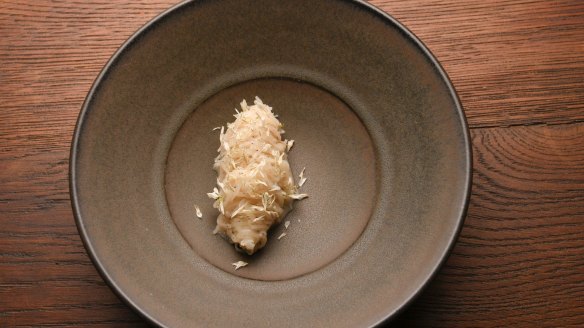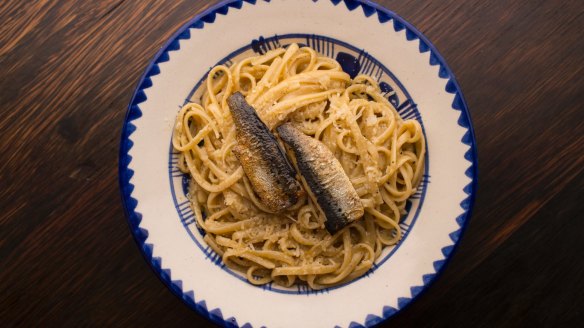Cacio e pepe is the simple dish that's captured Australia, but why?

You get to know dining trends intimately putting together the National Good Food Guide. When an ingredient or dish gets popular, we have the supreme honour and sometimes trial of eating it every which way. Sometimes that is excellent. Sometimes it means two years of slider purgatory. But chalk this year up as a win for the carb lovers. Cacio e pepe, Rome's great gift to mankind of pasta, pecorino and pepper, is having a moment in the sun.
As it should. The salty, sticky tumble of carbs with a backburner of heat is one of food's great unions. But why now?
Cacio e pepe has been building a social media presence for a couple of years, and was named king dish in New York back in early 2016. It's been around for significantly longer. The origin story goes back to ancient Rome. Shepherds would make the durable sheep milk cheese pecorino as they were tending their flocks in the hills over summer. Combined with pepper and a primitive version of pasta it would have been a simple, filling meal.

The dish evolved to use tonnarelli (square cut spaghetti), when pasta as we know it showed up a few centuries ago but then and now it remains a three-ingredient creation. The grated pecorino is emulsified with some starchy cooking water, before the pasta is tossed back through with loads of cracked black pepper. Adding oil, butter or cream evokes the same rage in purists you see when you mess with Rome's other staple, carbonara. Eating both pastas in the eternal city is as essential as seeing the Pantheon and getting flipped off by dudes on Vespas.
You've previously been able to find the dish in Australia, typically at Roman restaurants. Brisbane's 1889 does an ultra-salty banger. For extra theatre (Instagram), or possibly to value-add to the simple dish, places like Sydney's Buffalo Dining Club and Canberra's Molto (pictured) toss the pasta and pepper though a giant wheel of cheese.
Now, cacio has escaped into the wilds of wine bars like Melbourne's Bar Liberty and Sydney's Ode. There's even a vegan version made with kampot pepper and a faux parmesan at Melbourne's vegan haven Smith and Daughters.
Maybe it stems back to Massimo Bottura (the chef behind Osteria Francescana in Modena, No.1 on the World's 50 Best Restaurants list) and his great parmesan rescue of 2012? Following earthquakes that damaged nearly $200 million of the cheese, Bottura created a risotto recipe playing on cacio e pepe, and held a virtual global dinner party, encouraging people to use the stock. It worked, the cheese was sold. And peppery, cheesy carbs seeped into the collective subconscious.
Ask chefs and they're not sure how they've come to be cooking it at the same time. Bar Liberty chef Casey Wall says he didn't realise it was trendy. He created his for an Italian wine dinner and it stuck. He does know his addiction stems to eating it at New York's Lupo, when pasta guru Mark Ladner was on the pans. "It reminded me of biscuits and gravy and I was hooked."
Embla's Dave Verheul is doing a spin on the dish upstairs at new finer diner Lesa, tangling semi-dehydrated potato strands with the salty, peppery elements. "It's the grail," he says, "something incredibly delicious that is made of the bare minimum of ingredients." It also works incredibly well with Lesa's complex often biodynamic wines.
And maybe there's a clue. We're increasingly eating in venues where it's the drinks that lead the charge and dishes follow, not the other way around and cacio e pepe is the ultimate wine wingman. So it is at Liberty and Lesa, and Sydney's 10 William Street where their version comes crowned with a raw duck-egg yolk. Legend actually has it that Roman restaurateurs served the salty dish to make soldiers order more wine.
There's also the bigger trend of restaurants drilling down into comfort staples - things we'd always considered too homey to order out. Last year, that looked like a flock of roast chickens. This year it was tasty things on bread (see half the menu at Sydney's Poly) and salty, sticky spaghetti.
Whatever the reason we're tangled in cacio e pepe's delicious web, we're not fighting it.
Five to try
10 William Street 10 William Street, Paddington
It's almost a carbonara-cacio marriage at this wine bar, where the peppery pasta is draped with lardo and duck-egg yolk.
Bar Liberty 234 Johnston Street, Fitzroy, VIC
Casey Wall does an addictive pasta and this fairly traditional cacio e pepe is wildly hot, sharp and salty with perfect bite.
Ode Bar 251 Bondi Road, Bondi, NSW
Chef Ben Abiad has been putting this dish on his menus for a few years, and at his new Bondi bar he's beaching it up with sardines.
Smith and Daughters 175 Brunswick Street, Fitzroy, VIC
Chef Shannon Martinez is using convincing faux parmesan to create a thick noodled vegan take on the Roman classic. 175 Brunswick St, Fitzroy
Lesa 1/122 Russell St, Melbourne, VIC
All the intense flavours of cacio e pepe ping through in this non-pasta version using strands of dehydrated potato.
The Good Food Guide is in its second year as a national book, with hats awarded across Australia. The Good Food Guide 2019 launched on October 8 with our presenting partners Vittoria Coffee and Citi, and is on sale in newsagencies and bookstores or via thestore.com.au/gfg19 (delivery included), RRP $29.99.
Restaurant reviews, news and the hottest openings served to your inbox.
Sign up- More:
- Good Food Guide
